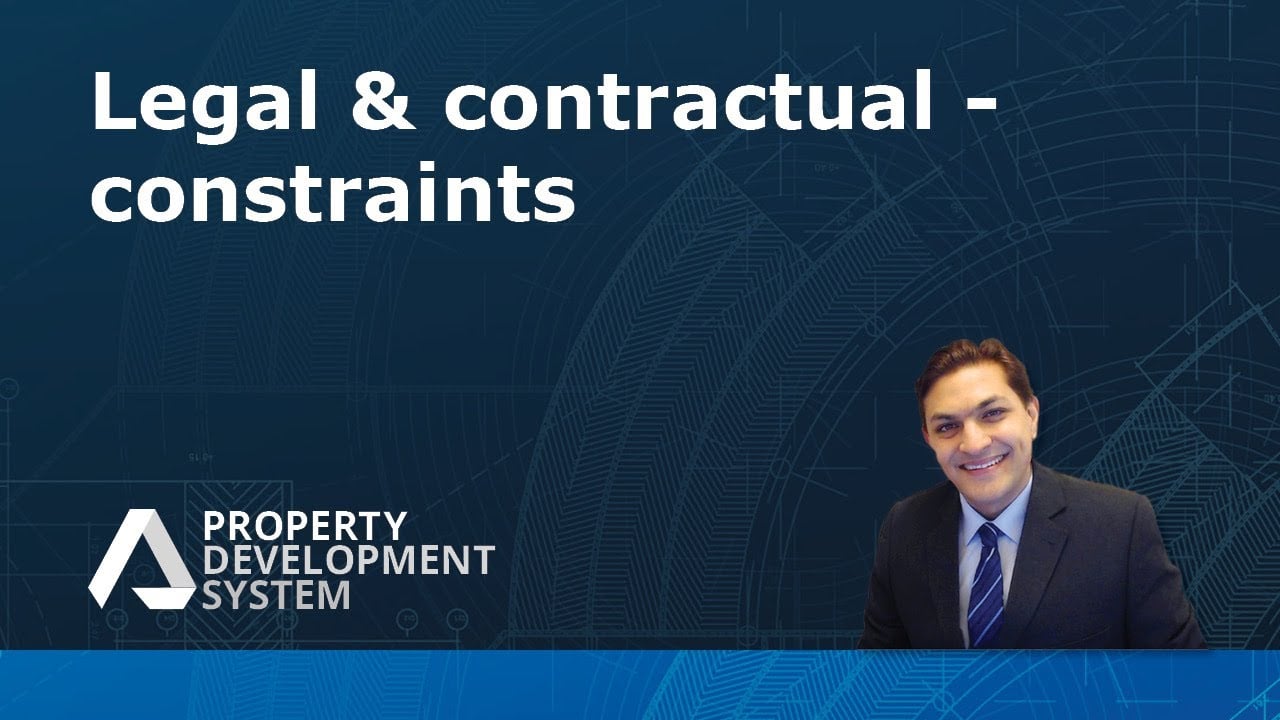Legal & Contractual - Constraints
Here are the critical insights into the myriad of legal and contractual considerations vital for property developers. It covers aspects from contracts of sale to construction agreements and their substantial impact on project viability and financial planning.
Contract of Sale
Terms, settlement times, and deposit conditions for land purchases.
Construction Contracts
Costs, deposits, contract length, delivery deadlines, and price variation terms.
Legal Restrictions
Clear land boundaries, rights, easements, and statutory authority rights.
Financial Impact
How legal and contractual issues influence financial feasibility.
Insights based on numbers
The segment emphasizes the importance of understanding specific contractual terms like settlement times and deposit requirements, which directly impact the financial planning and feasibility of property development projects.
Frequently Asked Questions
How do settlement times and deposit conditions affect the financial feasibility of a property development project?
Understanding the specifics of these contractual terms is essential for accurately forecasting the project’s financial outlook. Longer settlement times might offer developers more flexibility with their financial planning, while specific deposit conditions could impact cash flow and initial capital requirements. These factors directly influence a project’s viability, affecting budget allocation, risk assessment, and overall financial strategy.
What are the implications of legal restrictions like easements on property development?
Easements can have considerable implications on how a property can be developed, including restrictions on building locations, property access, and utility placement. Understanding these legal constraints is crucial for developers as they can affect the design, feasibility, and, ultimately, the profitability of the project. The video emphasises the importance of conducting a detailed analysis of any easements or other legal restrictions during the planning phase to mitigate potential risks and ensure compliance with all legal requirements.
In what ways do construction contract terms, such as price variation clauses, impact project budgeting?
It outlines that price variation clauses allow for adjustments in the contract price under certain conditions, such as changes in material costs or project specifications. These clauses are crucial for managing financial risks associated with fluctuating prices but require careful negotiation and understanding to ensure they do not unfavourably impact the project’s budget. The video stresses the importance of accurately incorporating potential price variations into financial plans to maintain budget control and avoid unforeseen expenses.
What are the legal and contractual constraints in property development?
Legal and contractual constraints in property development are the rules, regulations, and agreements that must be adhered to when developing property. These include aspects like contracts of sale, construction agreements, land boundaries, rights, easements, and statutory authority rights, which significantly impact project viability and financial planning.
What is a contract of sale, and what does it include?
A contract of sale outlines the terms, settlement times, and deposit conditions for land purchases. It is a legally binding agreement between the buyer and the seller, detailing the rights and obligations of each party regarding the sale of property. Settlement times refer to the period between the contract signing and the completion of the sale, while deposit conditions specify the amount and conditions under which the deposit is to be paid.
How do construction contracts affect property development?
Construction contracts are crucial in property development as they detail the agreement between the developer and the construction company. These contracts cover costs, deposits, contract length, delivery deadlines, and terms related to price variations. They are essential for planning the budget, timeline, and overall management of the development project.
What are legal restrictions, and how do they impact property development?
Legal restrictions include clear land boundaries, rights, easements, and statutory authority rights. These restrictions can significantly impact the development process by defining what can and cannot be done with the property. For example, easements may grant rights to use the property for specific purposes, such as utilities, which can affect construction plans and placements.
How do legal and contractual issues influence financial feasibility in property development?
Legal and contractual issues play a significant role in the financial feasibility of property development projects. Understanding specific contractual terms, such as settlement times and deposit requirements, is crucial for accurate financial planning. These elements directly impact cash flow, budget allocation, and the overall financial planning of the project, influencing its viability and success.
Why is understanding the financial impact of legal and contractual constraints important?
Understanding the financial impact of legal and contractual constraints is important because it allows property developers to accurately plan and budget for their projects. This understanding helps in identifying potential financial risks and in making informed decisions that ensure the project is financially viable and profitable.
Test Your Knowledge
Multiple-Choice Questions on Legal & Contractual Constraints in Property Development
1. What does a contract of sale in property development primarily include?
A. Only the price of the property.
B. Terms, settlement times, and deposit conditions for land purchases.
C. A detailed construction plan.
D. Insurance policies for property development.
2. Which of the following best describes the purpose of construction contracts in property development?
A. To ensure that the property taxes are minimised.
B. To outline the responsibilities and expectations between the developer and the construction company, including costs, deadlines, and contract length.
C. To provide a warranty for the completed property.
D. To secure loans from financial institutions.
3. Legal restrictions in property development can include:
A. The number of properties a developer can own.
B. Clear land boundaries, rights, easements, and statutory authority rights.
C. Mandatory inclusion of green spaces in the development plan.
D. A cap on the profit margins of the project.
4. How do legal and contractual issues influence the financial feasibility of a property development project?
A. By determining the marketing strategy for the development.
B. By influencing the project’s design and architectural style.
C. They have no significant influence as financial planning is independent of legal constraints.
D. By impacting cash flow, budget allocation, and overall financial planning, affecting the project’s viability.
5. Understanding specific contractual terms like settlement times and deposit requirements is crucial for:
A. Deciding the location of the property development project.
B. Estimating the number of workers needed for construction.
C. Financial planning and assessing the feasibility of property development projects.
D. Choosing the construction materials.
6. What role do easements play in property development?
A. They specify the types of buildings that can be constructed.
B. Grant rights to use the property for specific purposes, which can affect construction plans.
C. They are used to determine the sale price of the developed property.
D. Easements are agreements between the developer and the local government regarding tax rates
Answers:
- B. Terms, settlement times, and deposit conditions for land purchases.
- B. To outline the responsibilities and expectations between the developer and the construction company, including costs, deadlines, and contract length.
- B. Clear land boundaries, rights, easements, and statutory authority rights.
- D. By impacting cash flow, budget allocation, and overall financial planning, affecting the project’s viability.
- C. Financial planning and assessing the feasibility of property development projects.
- B. Grant rights to use the property for specific purposes, which can affect construction plans.
Assignment
Practical Exercise on Legal & Contractual Constraints in Property Development
Objective:
To apply the concepts learned about legal and contractual constraints in property development, focusing on contracts of sale, construction contracts, legal restrictions, and their financial impact. This exercise will help students understand how these constraints influence the planning, execution, and financial viability of property development projects.
Part 1: Analysis of a Contract of Sale
To Do:
Review a sample contract of sale provided by your instructor or find one online (ensure it’s for educational purposes). Identify the key terms, settlement times, and deposit conditions mentioned in the contract.
Write a brief report discussing how these elements (terms, settlement times, deposit conditions) can affect a property development project from a financial and legal standpoint.
Questions to Consider:
- How do the settlement times influence the project timeline?
- What are the implications of the deposit conditions on the project’s cash flow?
Part 2: Construction Contract Evaluation
To Do:
- Obtain a sample construction contract (again, make sure it’s appropriate for educational use). Analyze the costs, deposits, contract length, delivery deadlines, and price variation terms.
- Create a scenario analysis that illustrates how changes in the contract terms (e.g., an extension of the delivery deadline) might affect the overall project cost and timeline.
Questions to Consider:
- Which terms in the construction contract are most likely to influence the project’s budget and schedule?
- How do price variation terms protect both the developer and the construction company?
Part 3: Research on Legal Restrictions
To Do:
- Research a case study where legal restrictions (land boundaries, rights, easements, statutory authority rights) significantly impacted a property development project. This can be a historical case or a hypothetical scenario.
- Summarise the case study, focusing on the nature of the legal restrictions and how they affected the project’s development plan and outcome.
Questions to Consider:
- What strategies were used to overcome or accommodate the legal restrictions?
- Could the impact of these restrictions on the project have been mitigated with better planning or negotiation?
Part 4: Financial Impact Analysis
To Do:
- Using the insights from Parts 1, 2, and 3, develop a financial model that estimates the impact of legal and contractual issues on a hypothetical property development project. Consider factors like settlement times, deposit requirements, construction costs, and legal restrictions.
- Draft a financial feasibility report for your hypothetical project, incorporating insights based on numbers from the material.
Questions to Consider:
- How do legal and contractual constraints contribute to the financial risks of a property development project?
- What measures can be taken to mitigate these financial impacts?
Submission Requirements:
- Complete the tasks outlined in Parts 1-4.
- Compile your findings, reports, scenario analyses, case study summary, and financial model into a comprehensive portfolio.
- Ensure your portfolio is well-organized, clearly written, and demonstrates a deep understanding of the material.
- Submit your portfolio via mail or comments



